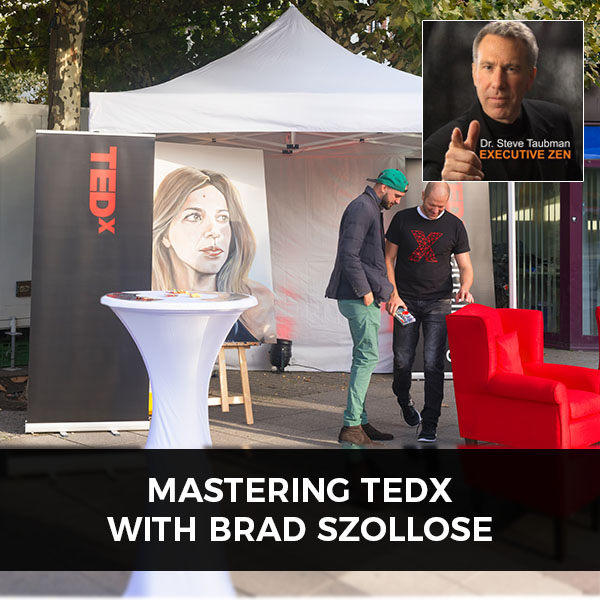
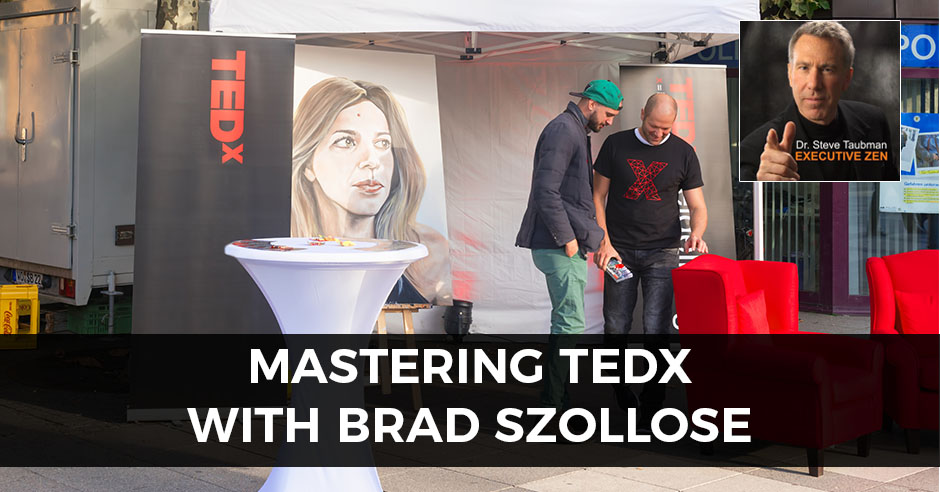
TEDXSpeaker, business consultant, web pioneer and former dot com executive, Brad Szollose is also the award-winning author of Liquid Leadership, which delves deeply into today’s modern management strategies that get Boomers and Millennials working together. He has been featured in Forbes, Inc. and New York Magazine, Advertising Age, and has appeared on television, radio and podcasts and other media outlets for his work in helping business leaders understanding the next generation. In this episode, Brad is going to share secrets to landing a TEDXTalk and leveraging it for business success. He’ll show you how it can turn you into an industry leader over night. Brad’s vast experience and sharp sense of humor promise to make this episode a really fun and informative one, so don’t miss it!
—
Listen to the podcast here:
Mastering TEDx with Brad Szollose
Our topic is Mastering TEDx, the spin-off of the TED Talks that have swept the nation, swept the world, and have made a humongous impression on the entire speaking industry. Our guest is an expert in this area as well as an expert in several other areas of note, to you, the executive. In your business and in your personal life, communication is vital. You need to be able to express yourself to bring a point across, to influence the thinking of others, to direct other people’s behaviors and attitudes.
Hopefully, if you’re in a business that includes getting people to buy your stuff or to do what they’re supposed to do at work, or whatever it happens to be. We’re constantly being called upon to be good communicators who empower others and get others to see things our way but not in a bossy way. Not in a way that minimizes the experience of others, but rather that helps draw them out. Education or educare, is the root education, is to draw out. We want to be good communicators who draw others out.
This TEDx model has been a useful model for codifying this idea. Whether you are out there in the business world on a day-to-day basis or you are on the TED stage, there are certain things that are necessary. We’re going to be talking about these with our guest. Being succinct and being impactful are vital to being a great leader. They are vital to being successful on the TED stage. We often have a tendency, and I know this is true for me as I now ramble along, telling you that we often ramble. I will often ramble. I’ll take an idea and I’ll run with it. Sometimes it’s because I like to hear the sound of my own voice. Sometimes it’s because I haven’t planned my words carefully enough, where I don’t have a clear enough sense of where I’m going.
That’s true of all of us. We tend to wander off in different directions. If we don’t know where we’re going, we end up risking the likelihood that we’re going to lose our audience or lose our customer. This TEDx training has value to us in many ways other than finding our way up on the stage. I want to say a few more words about this in order to give my guest, Brad Szollose, food for thought about how to correct everything that I said.
I have a tendency as a speaker, as a business person, and as a thought leader to want to teach everyone everything I know in one huge data dump. I want to put my ear up against your ear and have everything in my head get into your head without having to plan it, structure it, or come up with any clear, orderly way of presenting the material because I know so much, and so do you. We want to get that so much across to somebody else so that they can do whatever they need to do with it. If they’re an employee, we want them to know everything we know so they could do the job as well as we could do it. If they’re a customer, we want them to know everything we know so that it would be idiotic for them to do anything other than doing business with us.
If we’re on stage, we want them to know what we know because that’s why we’re there. We want them to get the value of our message. Every fiber of my being tells me that I’ve got to do that. I’ve got to throw it all up onto the wall and hoping it will all stick. This huge data dump concept seldom works. I’ve needed to remind myself that there is a methodology for communicating. When we use that methodology, we could create change, which is ultimately what we want to do. We want to create change in people’s perception, their attitude, their behaviors, and the data dump model doesn’t get the job done for us, so what does?
I believe that it’s two things. It’s order and clarity. The order is to take the message and break it down one step at a time. To have an outline, to have a pattern, to have a strategy, to gradually present a case and to present information. Part of the idea is creating order, which my busy brain doesn’t like. My busy brain wants to say it all until you get it. The other part of this is clarity. I’ve been somewhat blessed in this area and maybe it’s made up for my lack of order, to some extent.
Clarity means making sure that what I’ve expressed is what I wanted to express and it’s what you heard. Sometimes I get an idea and I happen to speak about things that are not all that clear to most people. I talk about mindfulness. I talk about self-awareness. I talk about being backstage to your own thinking. It sounds obvious when I say it, but to other people, they look at me like I’ve got three heads when I say it. To them, it’s not clear. I haven’t broken it down in a way that they can relate to.
What I’m trying to bring across and in anticipation of our guest’s arrival is this, the TEDx stage is an opportunity to exercise a new way of communicating. The people who do it well, the people who are masters, Brad being one of them, who have influenced, inspired and changed others. They’ve done it not because they’re cool people with interesting ideas floating around in their heads, but because they took the time to create order and clarity. They cared enough to distill their message down to one that could be heard.
As business people, we’re constantly being called upon to be good communicators who empower others. Click To TweetI know we’re going to be talking at some length about this idea because I watched the Founder of TED do a great video about the one idea. That the purpose of the TEDx stage is to present one idea. You may have a thousand great ideas and a thousand spins on each of them, but the idea of the TEDx stage is to express one idea. To change the way people think. To click something up in their brain so that they are forever changed. To me that’s magic and that’s amazing. Somebody who can do it has my undying respect and appreciation, and Brad is one of those people.
I will be speaking with my friend, Brad Szollose, a well-respected expert. Hopefully, he will set me straight about my wrap on TEDx and my wrap on communication. He’ll point out the irony of how much I rambled about not rambling. We’ll come away with ideas to improve your business, to improve your communication if you happen to have the aspiration yourself to be a TEDx speaker, to maybe learn a little bit about how to master the art form. Our topic is To Master TEDx. I’ll be speaking with speaker, author, entrepreneur, designer, and friend, Brad Szollose.
—
Our guest is a TEDx Speaker, business consultant, Web Pioneer, and former Dot-com Executive, Brad Szollose. Brad is the award-winning author of Liquid Leadership, which delves deeply in modern management strategies that get boomers and millennials working together. He’s been featured in Forbes, Inc., New York Magazine, Advertising Age, and has appeared on television, radio, podcasts, and other media outlets for his work in understanding the next generation. On a personal note, Brad and I met at a conference for Think and Grow Rich. We started an instant bromance that has blossomed into a great relationship.

Mastering TEDx: The idea of the TEDx stage is to express one idea, to change the way people think, to click something in their brain so that they are forever changed, and that’s magic.
Brad’s going to switch roles on executives and talk about mastering the TED stage. In 2016, Brad was awarded a TED Talk in Tarrytown and his life hasn’t been the same since. Brad’s been speaking and coaching for hundreds of thousands of people for over the past twenty years, CEOs, professionals, comedians, corporate presenters, celebrities, royal families, and entrepreneurs. Brad’s going to share his secrets to landing TEDx Talks, how to leverage your talk for business and how to instantly turn you into an industry leader overnight. Get ready for TEDx, TED Talk mastery with Brad Szollose.
Steve, how are you doing?
Did you hear my wrap on TEDx, communication and all that?
You were rambling about rambling. I have a better word for it, I would say me meandering. Dr. Steve has a wonderful doggie named Woody and that’s what you guys do. You wander through the woods, explore, and have an adventure. That ties in definitely to what we’re talking about. I don’t know about you Steve, but when I heard a TED Talk is fifteen minutes, I sit there and go, “How in the heck do you get across what you want to say in fifteen minutes?” As a professional speaker, you know what I’m talking about.
Abraham Lincoln gave the Gettysburg Address and it was three minutes long and it’s considered one of the greatest speeches ever. The keynote speaker of the day spoke for two hours in the heat before Abraham Lincoln went up to deliver the Gettysburg Address, a three-minute speech. Who was that speaker? That was Edward Everett. A lot of people, if you ask them, “Who was the keynote speaker before Lincoln, who spoke for two hours in the heat?” Most people will look at you and go, “I don’t know.” That will tell you the power of the short talk. I didn’t know about this short talk myself. If you go back in time, I didn’t even know speaking as a career.
When I was on Wall Street and I’d taken my company public, K2 Design, I noticed that my business partners, every time we had a shareholders meeting or we had a public event, they would always acquiesce to me to start the meeting, give the speeches and even in presentations. I thought to myself, “Why are these guys so afraid to speak in public?” I realized I had that je ne sais quoi, that natural ability to get up and communicate. Communication is the key, especially if you’re in the executive suite. Myself, being a former C-level executive, I would shock people sometimes because I somehow figured out how to communicate with them and get my crazy ideas across.
This is the most important subject of our day because we have a lot of young people who have never been taught how to have a conversation, a face-to-face conversation, and haven’t been taught the fine art of communicating. The millennials and the Gen X-ers that do have these skills and can hold a conversation, close more business, connect more with upper management and the C-level, and their careers move swifter, better, and faster. You can tell in every organization the person who’s the master communicator, not just with their team, but with the people around them and the people that trust them to be in charge of running a team. Have you noticed that as well, Steve? You travel a lot and work with corporations, but you’ve noticed there’s always one person in the room that has this, “That guy’s a go-getter or that woman’s a go-getter.” Am I right?
There’s no question about it. That whole idea that who you are speak so loudly that I can’t hear what you’re saying. They exude an energy that’s obvious, that goes beyond words.
Your presence says a lot. If you’re someone who needs to learn how to communicate, a lot of people go to Toastmasters. People hire me as a coach to get them out of that shell because it’s not a natural state sometimes for somebody who’s gotten all the right degrees, worked in business, expect people to do what they’re supposed to do. Suddenly, you’re supposed to be a great communicator on a stage at an annual meeting for your sales division. How do you do that? That’s not natural.
I can tell you this. From the TEDx stage and I was lucky enough to be awarded a TED Talk at the right time and the right subject. I chose to speak about how video games have changed the communication and behavioral styles of the next generation, the millennials and how that impacts corporate training, education, and how we communicate. Those fifteen minutes of fame that I got, that closes more business than you can imagine.
The TEDx stage is an opportunity to exercise a new way of communicating. Click To TweetI had somebody call me up for a keynote speech and I was in the running with five other keynoters. For those of you who don’t know how the business works, they have a committee and that committee goes through several layers and then they decide. I said to the woman on the phone, “I am jazzed that I got this far in the process and I appreciate it. If you could, show the committee my TED Talk.” All of a sudden, she changed. She went, “You did a TED Talk? That cinches it,” and I landed the talk immediately because I had been on a TED stage. You don’t want to mail this in. This is the talk of your life. The TED Talk is not about business and yet it is about business.
You can close business with a TED Talk because you have to get one idea solidified for your talk. A lot of you in our audience are smart. You’re incredibly smart. We all are, but it took me years to learn that your audience doesn’t remember much of anything. If you do an hour and a half talk and the audience is on the edge of their seat and they love what you’re doing, they still only take away and can remember three things from your talk. Part of the reason is they’re being bombarded with so much information because I doubt if you’re going to be the only speaker on that stage. They’re trying with their mind to grasp and remember certain keys from each speaker that’s been on that stage. By the time you get there, you’re lucky if they remember one big chunk.
The TED Talk is simple, it’s easy, it’s one idea, but that’s the hardest thing for smart people to do is speak about one idea for eighteen minutes. That’s the hardest part about a TED Talk. When I was putting my talk together, I had three solid influences that changed the behavior of millennials, created millennials. I realized I couldn’t get all three in, not even as a sidebar. I did not have enough time to talk about all three, so I chose one. The main one was video games. That was the huge interrupter that trained millennials in business strategies and Gen X-ers in business strategies before they became adults. They were working with high-end technology by that time.
Using Occam’s razor, I have to shave it down. All of a sudden, the talk became better and I kept practicing. They always have a practice session a month before the TED event. The talk I gave in both practices, the one the night before and the one the month before, is not the talk I gave on stage. Part of the reason is I kept the last five minutes up in the air between two to three different stories that I thought the audience would like better. When you’re a professional speaker and you’ve been doing this long enough, you can read an audience pretty well.

Mastering TEDx: Who you are speaks so loudly that I can’t hear what you’re saying.
If you watch the last five minutes of my TED Talk, The Age of Radical Disruption, you’ll see where I shift into this final story. That’s the exciting part of helping people not only land a TED Talk but decide what they want to say on stage. It’s breaking it down to that one idea that can help change their life or change someone else’s life in the audience. Can you speak about one subject for fifteen minutes?
I’m flabbergasted listening to this because my brain wants to rebel so badly against what you’re saying even though I get it, I’ve seen it, and I know it’s true. If I expound on this one idea clearly, what about the other ideas? Do they come through by osmosis? You talked about video games, but somehow that was almost a metaphor for other ways in which millennials are different.
This used to bug me because I liked to prepare for my talks. I used to have seven points. I’d write them out in an outline. I’d put them in the word. I’d be going through every story how I was going to blow their mind. I did this for years and I realized I was giving too much information. Every coach should have a coach. Don’t trust the coach who’s helping you that doesn’t have a coach. I reached out to my coach and said, “What do you think here?” He was like, “You’re lecturing.” I said, “What’s the difference?” He goes, “You are hired to be a keynote speaker. Your main job is to give some information but to entertain.” I was flabbergasted by that. He goes, “You’re not a lecturer. Lecturers are for professors in college.”
A lot of us want to prove we’re the smartest person in the room. That’s great and all. “Look at the big brain on Brad,” but the reality is this. People in the room are not going to retain all that information you’re throwing at them unless they’re taking notes. Your job in the first five minutes of any talk that you give is to be entertaining. Prove to the audience that you’re not like every other speaker, “Hi, I’m so happy to be here.” you take those phrases out, and you’re going to present an information that’s either innovative or counterintuitive. Remember those two words. If I can Google it in less than five minutes, it’s not relevant because anybody can get that information. It’s the information I can’t get that I need to know. That’s what you’re bringing to the stage.
The power of a TED Talk will not only change the course and the direction of your business, but it also will change your personal life. Here’s how it is. You will instantaneously overnight become a thought leader in your industry. This is my favorite TED Talk of all time and that is Daniel Pink, and it was originally titled Drive, the science behind what motivates us. I suggest everybody go watch Daniel Pink’s TED Talk because it led to his book and it led to a series of books on what motivates us, how we’re going to be freelancing the future, all of these different things. This leads me back to what I always was saying. It’s about business, but it’s not about business.
If you talk about pure business, you’ll be rejected for a TED Talk. If you talk about what you’ve learned through business or you may mention your consulting or some of the businesses that you work with, you will drive people to get your idea as a truth in their world. Daniel Pink is the first one I always talk about. Have you ever seen that talk?
I have. I’ve read the book and I spoke with Daniel. He’s a great speaker.
I love Daniel’s message and it has led to motivating people in the 21st century. If you watch his TED Talk, he comes out and basically says, “I have a case. I used to be a lawyer,” and he makes you laugh about how bad of a lawyer he was. He starts talking, “I’m going to present a case for you.” He goes, “That case starts with puzzle solving,” and he goes through all the research that MIT and the London School of Economics broke down in order to figure out what motivates us. All of a sudden, he turns around and he says, “We’ve been going about this all wrong.” By the time you’re done, you’re sitting there going, “He’s right. I didn’t know that.” It’s all like, “Pardon me, BS.”
The TED talk is not about business and yet it is about business. Click To TweetThe way he presents the case is the platform for all of our modern management ideologies on motivating workers. It’s all because of one TED Talk. That talk has been watched over a million times, but it literally launched Daniel Pink’s career. I want anybody in our audience to understand this. I work with other professional speakers. They are not in the running if you have a TED Talk. If you have somebody who’s competing with five other speakers, the TED Talk speaker is going to be moved to the front of the line because it has become the ubiquitous standard for all speaking engagements.
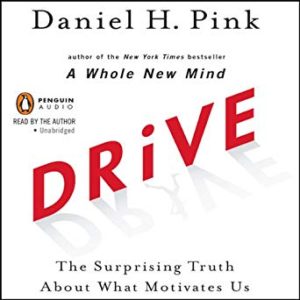
Drive: The Surprising Truth About What Motivates Us
Those fifteen minutes show people, “If that person can get across that in fifteen minutes, then they must be incredible if I hire them for 90 minutes.” It’s going to drive people to your business. It’s going to drive the people to what you stand for. It’s going to instantaneously give you credibility. It’s also going to show how authentic and credible you are about the subject you’re talking about. I hope some of this helps. People are taking notes or reach out to me and talk about what you want to talk about onstage. I truly believe anybody can get a TED Talk if you present what you want to talk about in the right light.
For one thing, don’t talk strictly about business, but talk about a principle or an idea that may be applicable to business and applicable to life in other ways. Number two, be innovative and/or counterintuitive so you’re not touting the same old party line. Maybe create a little bit of surprise or a little bit of what I call slapping people in the face, but in a positive way.
I play drums at the very beginning of my TED Talk. For those of you who haven’t seen it, you’re probably thinking, “What does drumming have to do with the millennials?” I specialize in the modern management theories and Millennial motivation. It has a lot to do with it when you realize almost 40 years later, my nephew learned how to play the drums on a video game called Rock Band with three other people from all over the world. I couldn’t figure out how to tie my TED Talk together from drumming to what I do for a living and it dawned on me one day. One of my best stories from the stage is my nephew Sebastian. I come into the living room and I said, “Sebastian, we’ve got to leave,” and he’s beating up this plastic drum set while playing Rock Band, this video game.
He says, “I can’t go, Uncle Brad. I’ve got two other songs,” and I’m like, “We’ve got to go now. Your mom’s coming on a train.” He goes, “You don’t understand, Uncle Brad. You see the woman on guitar? She’s in Tokyo, Japan. You see the other guy on bass? He’s in Paris, France. We’re almost done.” I went, “What?” The kid’s sitting right here in the living room and he’s working with somebody from Tokyo and somebody from Paris. My presentation style, I use the toys from our generation and the toys from the next generation. Usually, after I do that, there is no argument about the generational divide. It’s sit down and listens now. It’s from two simple props that I carry with me, the Nintendo 64 controller and a GAF View-Master.
When I show those two devices, the Boomers in the audience go back to ten years of age. I literally, from the stage, see ten-year-olds instead of 50-year-olds and they’re reaching up and they want to touch it. They want to touch the GAF View-Master. They’re like, “I remember that.” Your real goal as a speaker is not the information, but to blow people’s minds, to get them to sit forward and go, “Wow.” If you can do that in the first five minutes, it doesn’t matter what you do for the rest of the talk, they are on board with you. You have to get people on board with you in the first 30 seconds to five minutes and that’s not easy. Professional speakers use a technique and we use four little words and they are, “Imagine for a moment.”
If you begin with that and you stopped saying, “I did this,” or, “I did that,” and instead put it in the you language of the audience. You will change how people listen to you from the very moment you open your mouth. I’ll give you a good example. I used to tell the story of how my father used to burst into my room when I was eighteen and he says, “You’re a man now. According to the law, you have three choices in this household. You can get a job and start paying room and board around here, buddy, or you can go to college and I’ll try and help you with that.” I’m like, “What’s the third choice?” He’s like, “You can move out and move in with your buddies, your loser friends.” I’m like, “Dad?” He’s like, “My house, my rules.” When I tell that story, it’s funny. A lot of us can relate to it.
If I set it up differently and it’s not me language saying, “I did this, I did that.” Instead, I turn around and they go, “Imagine for a moment it’s the morning of your 18th birthday. You’re lying in bed, you’re happy. You’re thinking, “I’m eighteen now. I’m growing up. Your dad knocks on the door, he comes in. He looks you dead in the eye and he says, “According to the law, you’re a man now. You have three choices from this day forward. You can get a job and start paying room and board around here, or you can go to college and I’ll try and help you.” You’re like, “Dad, what’s the third choice?” “You can pack up and move out. It’s my house, my rules. Don’t tell your mother we had this conversation.”
When you change how you tell the story, two things take place. The audience sits forward and they begin to imagine it from their perspective. What was the morning like for their 18th birthday? The jokes can come from that easier as well. Usually say after that, “Some of you are going to have to make something up because that 18th birthday was a long time ago. Some of you, it wasn’t that long ago. You started shaving a couple of years ago.” Some of them started laughing. Some of them are like, “I remember.” We remember milestone birthdays like our 18th birthday, but you want to put the idea in their head when you’re telling a story. Once you learn the power of that, you will never have a bored audience. They will always be imagining it from their perspective.
It’s a great speaker’s tool. It’s also a great hypnotic tool. As a hypnotist, my job is to help you imagine that, which is not happening right now. “Imagine you’re stuck to the chair,” and our imaginations are powerful. If you can access somebody’s imagination, then you’re essentially hypnotized and they’re essentially putty it in your hands.
I’ve seen a hypnotist hypnotize somebody to not see their daughter when the daughter’s right in front of them. That is the power of our imagination. As a speaker, this is where a lot of smart people get tripped up. Only smart people want to become speakers because you have an idea that you want to get across. That takes somebody who sees something a little bit differently and the sign of intelligence. Here’s where we get tripped up. I learned this from my good friend Tim Davis, who’s a corporate speaker and a coach. He’s trained in DISC Behavioral Training and he’s spoken at incredible colleges. He used to be a New York cab driver and stand-up comedian. He trained himself to be able to speak in such a way using Socratic Methods that nobody can win an argument with this guy.
He told me he was hired by one of the social services groups that were helping young girls who got pregnant at a young age, fifteen to seventeen. They had to find a way to live life, live on their own, raise their child, and do all these things. The PhD’s in the room who were designing the curriculums, writing the reports and the brochures and all this. Tim was about to go on stage and he asked the woman who hired him and he goes, “Why did you hire me again?” She basically said, “These guys can’t understand why the fifteen and seventeen-year-olds aren’t doing what they say.” He goes, “I got it.”
If someone can Google it in less than five minutes, then you’re not relevant because anybody can get that information. Click To TweetThe first thing he did is when he went out on stage, he goes, “You guys don’t seem to understand. You’re the smartest people in the world in this room. You know what you’re talking about. You’re beyond brilliant. Every one of you can have a conversation with each other, but the people who read your brochures, they’re fifteen and seventeen year-old-girls who got pregnant. They don’t understand anything that you’re writing.” He said, “You’ve got to bring it down to their language, to what they understand, instead of sitting here and trying to say, “They got to get more intelligent.” If they could do that, they would have done it a while ago.
That’s an important takeaway because whether you’re on the TEDx stage or your inspiring people or educating people, the meaning of a communication is the response you receive. “I’m smart. I communicated well, so you’re an idiot for not getting it.” If I communicated and you didn’t get it, that’s on me. It’s my responsibility to shift the way I’m doing it so that you can hear it from your framework.
When I made that shift, I started getting standing ovations and I started to get more people booking me. I spoke at an insurance conference and from that one conference alone I received over seven more bookings through the years. People will remember the heck out of you if you get up there, you blow their mind, you’re fun, you’re entertaining, you make them laugh, and then you leave the stage. A lot of us make the mistake, and I used to do this too. I’m preaching to the choir. I used to think, “I have to prove I’m the smartest person in the room because why else would I be on the stage?” Now, I’m happy if I can communicate and make you laugh for an hour and a half with me, or fifteen minutes because I’m trying to get out across one idea at a time.
This is the power of storytelling. Don’t think I’m somebody who hasn’t bled in the trenches either. A lot of the speakers are talking nonsense in the business world. Did you notice that 95% of business speakers, professors who teach business, and people who publish books on business have never owned a business? This is a staggering statistic when you realize it. What happens is I’m one of the few people who’s bit my nails on a Thursday night trying to figure out how to make payroll for Friday. Until we went public, it was always about juggling money. Do you think maybe when I get onstage I might have some practical advice that would blow people’s minds instead of running through a list of statistics? Probably. I have a unique perspective.
When I speak, people listen a little bit. I’ve gone from the entrepreneur startup to the C-level executive, being a Chief Marketing Officer for my company for investor relations, the public persona, as well as other clients. When I speak, I make sure I give them something that no one else is talking about. This happened, somebody wanted to know, “What was the reason you started your businesses?” All these people were talking, “I wanted to change the world,” and, “I wanted to bring meaning to the world,” and somebody came to me and they said, “What drove you to start all your nine businesses?” I said, “Anger.” There was this murmur and everybody sat forward. You could physically see everybody move forward. I said, “I’m not discounting what everybody said about, ‘I want to change the world,’ and, ‘This is my passion.’ Every business I’ve ever started was out of frustration and anger because somebody didn’t see what was coming. Somebody did not see the trend.”
When I started K2, a lot of people didn’t know that the internet was coming. I didn’t at that moment, but I got on board with it and we went from two people in an office to 60 employees all of a sudden. We’re listed in the Wall Street Journal, evaluated at $26 million. It was all because I could see a trend coming. I was furious with everybody around me who didn’t see it. I could see the writing on the wall with computers coming and I wasn’t making enough money. That was another reason. I said, “You know what? I’m starting a business.” You wouldn’t believe how everybody in that room wanted to have questions with me simply because I did not do what everybody else was talking about. I said, “I was angry. That’s how I start businesses. I’m mad.”
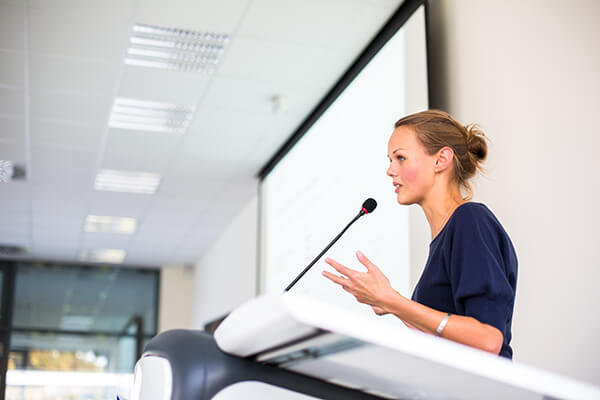
Mastering TEDx: Only smart people want to become speakers because you have an idea that you want to get across.
I love this conversation because it’s great history and it’s fun, but if we pull it back to the whole speaking world, the TED world, what you’re demonstrating is that you’re not doing what everybody else is doing. That you’ve got to march to your own drummer. The counterintuitive, the innovative piece is a big part of this. You said this idea about, “Imagine for a moment,” and I want you to bring that back to the context in which you said it. Was that a suggestion for an opening for a talk? What was that meant to convey?
Every time you give a talk that I have a formula for writing out and creating a 90-minute talk and that is a statement, then a story, and then you bring it back to the original statement with a couple of tweaks. When you tell a story, it is incredibly important. This is how you become a master storyteller and that is this. Every great story has a beginning, middle, and end. It has to have a point that drives you through the hero’s journey. You will get an audience’s attention faster if you shift the language to you language. Meaning, “Imagine for a moment you are going through this and then you stumble with this and then you go through that.”
That would constitute the statement part of this formula? Your first statement is a you statement. You’re asking your audience to put themselves in a particular position.
One of my best stories that come from Dot-com boom and I turn around and I look at everybody to go, “Are you in the middle of a revolution and you don’t know it?” Then I repeat it, “Are you in the middle of a revolution and you don’t know it?” and then I start to tell the story of being one of the first Dot-com companies trying to sell stuff to everybody else in the Dot-com world. At some point, you do shift the story back to you or I language. I go, “Imagine you’re trying to sell the very first websites to people who don’t even know what a website is. What would you do in that moment?” You wouldn’t do what we did and that is create a fake presentation on a laptop, that’s called vaporware in the software industry, and try to sell it to everybody. I go around and I tell the story of how we kept trying to sell the internet to people and they glazed over at the end of every interview. They would hire us for various projects but not the internet.
The power of a TED talk will not only change the course in the direction of your business, but it will also change your personal life. Click To TweetOne day, we presented on a laptop and this older executive stood up and said, “Could you guys create a CD-ROM hybrid that would launch a proprietary browser that would take people to a password-protected section of our website? Could you guys do that?” A lot of you in our audience know exactly what I’m talking about, but in 1995, nobody knew what that phrase was except us. What would you do at that moment? You hear how I’m saying that and your response is, “I don’t know.” I said, “You wouldn’t sit there in dumbfounded silence like we did for ten seconds.” You see how you shift a few lines in your story and it makes people go, “My goodness,” and then I said, “We started asking better questions because this became a pattern.”
When we started asking executives, especially if they have gray hair, how come they knew so much about the internet? They all had the same response, their grandkids. That’s when we began to analyze the landscape and we saw there was a huge problem inside every corporation, at the very top of every organization. If they had grandkids, the executives, they knew all about the internet. At the very bottom of every organization, if they were right out of college, first or second job, they knew all about digital archiving, what the internet was for, how to reach people.
In the center of every organization, they were in the middle of this digital revolution and didn’t know it. I stopped at that moment and I look around the audience and I say, “Again, are you in the middle of a revolution and you might not know it?” and that’s when everybody is on the edge of their seat. It’s point, story, point. That’s how you build a great talk. When people are on the edge of their seat, now that story makes sense as to why millennials act differently. I said, “I now had a staff that was acting completely bizarre to me.”

Mastering TEDx: Every great story has a beginning, a middle, and and end. It has to have a point that drives you through the hero’s journey.
I’m a Boomer, so everybody’s not obeying the rules. “Why aren’t you obeying the rules? Don’t you know who I am?” I realize they don’t care about authority. They don’t care where your position is in the hierarchy. To get that across in one story is the most powerful thing you can do. That’s the power of the TED stage, the fifteen-minute talk, the short talk, and almost every single event company is moving to the fifteen-minute format. They can get more speakers on stage. It pushes the game a little bit. Every speaker has got to be good. You’ve got to connect with that audience immediately. Steve, how many times have you been at a pharmaceutical conference? I’m going to get very specific. You’re in the back of the room waiting to go on. You hear the Executive Vice President of Marketing talking for almost 40 minutes and they never connect with the audience until twenty minutes in. The moment they connect with the audience, it’s always the same way. They tell a story from the heart.
When they tell a story from the heart, the energy shifts. Their energy shifts completely. My job as a TEDx coach and speaking coach is to get you to tell that story immediately. The first second you’re out of the gate, on the stage, in the center of the spotlight, you tell that story that connects to the heart. That’s how you connect to an audience. That’s how you should connect to an audience all the time. It doesn’t matter if you’re talking to employees, if you’re talking to your wife or your husband, or you’re talking to anybody. You got to come from the heart immediately. If we get stuck in our head, we become a boring speaker. We have to drop into the heart and tell the story authentically as to why we’re standing on that stage. That’s the number one story. Why do you do what you do today?
That’s an important question. If I express my why, then I’m being more authentically human and you’re going to connect with me by virtue of the fact that I’m sharing. Even if my why is not your why. How can people learn more about you?
The meaning of communication is the response you receive. Click To TweetYou can go to LiquidLeadership.com, which is the title of my award-winning book. You can email me at Brad@LiquidLeadership.com.
If you’ve enjoyed the show, please send your comments to SteveTaubman@Gmail.com and feel free to suggest a topic that’s particularly meaningful to you. If you’d like to learn how to bring me to your company to create a mindful, holistic organization of fearless leaders, contact me through SteveTaubman.com. We end our show with a metaphor, a quote, and a challenge. Before we do, I’m still wondering what Brad was referring to in his introduction when he mentioned the Royal Family.

Mastering TEDx: We are by nature ramblers but there’s a science and art to communicating which involves discretion, discernment, and the ability to peal away the layers of extraneous and leave on the part that matters, the part that influence people to move.
Not the Royal Family, but one of the royal bloodlines, the Medici family contacted me on a big project they’re working on. I’m proud to know them as friends, work with them, and be able to help them have a big dream come true. I can’t talk about the project. The main contact there has been a friend for many years. He had disappeared for a little while traveling in Europe and then he comes back. He goes, “Brad, could you help me with something?” I said, “Absolutely.” It wasn’t suddenly I got this royal decree and I was flown in a jet. That would be nice someday. I would look forward to that.
The Medici family. I only know them from watching that show about Da Vinci. We like to end our show with a metaphor, a quote, and a challenge. Ordinarily, I take on the metaphor and a quote and I give the challenge to our guest. I’m going to double-duty Brad on this. First, I will suggest a metaphor, however, because as I listened to the conversation that we had, what occurred to me was this. By our nature, we’re ramblers. We’ve got a lot to say, but there’s a science and an art to communicating. That science and art involve discretion, discernment, and the ability to peel away the layers of the extraneous and leave only the part that matters, only the part that influences, only the part that moves people.
As you utilize the material from this episode, whether it is to get yourself on a TED stage and I encourage you to reach out to Brad about that or to improve your communication with your team, I want you to use this metaphor. The metaphor is the sculptor. As a sculptor, your job is to chip away everything that isn’t the sculpture that you’re making. You’re starting out with a lot of stuff and your job is to begin to chip away everything other than that, which is beautiful, that which has an impact. Start thinking about what that big rock looks like that you have been throwing at people. See which pieces of it you can chip away, thus leaving only that, which is beautiful and impactful. Brad has given us a few good tools to do that. Some humor, some stories, some use of statements, and a lot of neat stuff. That’s my metaphor. Brad has a quote for you.
This is a quote that I love from actor, rapper, and provocateur Mos Def. This is a great quote, I love it. “My presence speaks volumes before I say a word.”
This show is all about presence, that one resonates for me. Thank you for that. Can I impose upon you in one more way and ask you to share a challenge with our guest? Something that they might do that’ll move them further down the road toward their goals and dreams?
When a person tells a story from the heart, the energy shifts completely. Click To TweetI want you to find the strange bird, the odd duck, the weirdo in your life, whoever that might be. That might be an employee, that might be your own teenage kid, that might be somebody that makes you turn your head to the side. Take them out for coffee. Take them out for dinner. Ask them what they’re passionate about, without judgment, without sitting there thinking, “I’m older and wiser and you probably shouldn’t dye your hair purple at work.” Put that aside and listen to what they have to say. You would be shocked at what drives people. I had a friend do this and he owned a company. The odd duck in his company, he took him out and he found out he loved to write. He put him on the team that wrote proposals and they started winning bigger contracts by taking out to dinner the one odd duck in the organization. Try to do that. You’ll be surprised.
Can I suggest that that is in complete consistency with what you were saying about counterintuitive and innovative? Let’s start looking for the thing that isn’t what everybody thinks. Let’s bring that to the stage. Brad, thank you very much. This has been an illuminating conversation. I appreciate you having been here.
Thank you.
When we return, my guest will be the wonderful Jason Freeman. I don’t know how many of you have gotten a chance to see Jason. He’s a relatively new friend and a speaker who speaks from the heart and with a unique spin on things about being perfectly imperfect. I look forward to having that conversation. Share this with your friends, subscribe to my podcast, visit iTunes, and find my channel Executive Zen. Remember, live consciously and profit responsibly.
Important Links:
- Brad Szollose
- Liquid Leadership
- Daniel Pink’s TED Talk
- LiquidLeadership.com
- Brad@LiquidLeadership.com
- Tim Davis
- Jason Freeman
About Brad Szollose
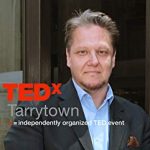
Brad Szollose is a TEDX Speaker, international bestselling author, management consultant, and the foremost expert on Cross-Generational Leadership Development. As a Web Pioneer, Brad co-founded K2 Design, Inc., the first dot-com agency to go public on Nasdaq.
Mr. Szollose has been featured in Forbes, New York Magazine, Inc., Advertising Age, and The International Business Times to name a few.
Companies like MasterCard Worldwide, Allstate, Liquidnet and Tony Robbin’s Research have engaged Brad for workshops, webinars and keynotes showing their people managers how to ignite the power of a new type of workforce.